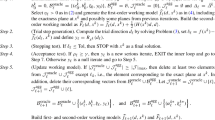Abstract
We propose primal–dual path-following Mehrotra-type predictor–corrector methods for solving convex quadratic semidefinite programming (QSDP) problems of the form: \(\min_{X} \{\frac{1}{2} X\bullet \mathcal{Q}(X) + C\bullet X : \mathcal{A} (X) = b, X\succeq 0\}\), where \(\mathcal{Q}\) is a self-adjoint positive semidefinite linear operator on \(\mathcal{S}^n\), b∈R m, and \(\mathcal{A}\) is a linear map from \(\mathcal{S}^n\) to R m. At each interior-point iteration, the search direction is computed from a dense symmetric indefinite linear system (called the augmented equation) of dimension m + n(n + 1)/2. Such linear systems are typically very large and can only be solved by iterative methods. We propose three classes of preconditioners for the augmented equation, and show that the corresponding preconditioned matrices have favorable asymptotic eigenvalue distributions for fast convergence under suitable nondegeneracy assumptions. Numerical experiments on a variety of QSDPs with n up to 1600 are performed and the computational results show that our methods are efficient and robust.
Similar content being viewed by others
References
Alfakih A.Y., Khandani A. and Wolkowicz H. (1999). Solving Euclidean distance matrix completion problems via semidefinite programming. Comput. Optim. Appl. 12: 13–30
Alizadeh F., Haeberly J.-P.A. and Overton M.L. (1997). Complementarity and nondegeneracy in semidefinite programming.. Math. Program. 77: 111–128
Alizadeh F., Haeberly J.-P.A. and Overton M.L. (1998). Primal–dual interior-point methods for semidefinite programming: convergence results, stability and numerical results. SIAM J. Optim. 8: 746–768
Anjos, M.F., Higham, N.J., Takouda, P.L., Wolkowicz, H.: A semidefinite programming approach for the nearest correlation matrix problem. Research Report, Department of Combinatorics and Optimization, University of Waterloo (2003)
Benzi, M., Golub, G.H., Liesen, J.: Numerical solution of saddle point problems. Acta Numer. 1–137 (2005)
Benzi M. and Simoncini V. (2006). On the eigenvalues of a class of saddle point matrices. Numer. Math. 103: 173–196
Bergamaschi L., Gondzio J. and Zilli G. (2004). Preconditioning indefinite systems in interior point methods for optimization. Comput. Optim. Appl. 28: 149–171
Berman H.M., Westbrook J., Feng Z., Gilliland G., Bhat T.N., Weissig H., Shindyalov I.N. and Bourne P.E. (2000). The protein data bank. Nucl. Acids Res. 28: 235–242
Bhatia R. and Kittaneh F. (1990). Norm inequalities for partitioned operators and an application. Math. Ann. 287: 719–726
Burer S., Monteiro R.D.C. and Zhang Y. (2002). Solving a class of semidefinite programs via nonlinear programming. Math. Program. 93: 97–122
Freund, R.W., Nachtigal, N.M.: A new Krylov-subspace method for symmetric indefinite linear systems. In: Ames W.F. (ed.) Proceedings of the 14th IMACS World Congress on Computational and Applied Mathematics, Atlanta, USA, pp. 1253–1256 (1994)
Fujisawa K., Kojima M. and Nakata K. (1997). Exploiting sparsity in primal-dual interior-point method for semidefinite programming. Math. Program. 79: 235–253
Halicka M., Roos C. and Klerk E. (2005). Limiting behaviour of the central path in semidefinite optimization. Optim. Methods Softw. 20: 99–113
Higham N.J. (2002). Computing the nearest correlation matrix—a problem from finance. IMA J. Numer. Anal. 22: 329–343
Horn, R., Johnson, C. Matrix Analysis. Cambridge University Press, Cambridge (1998)
Keller C., Gould N.I.M. and Wathen A.J. (2000). Constraint preconditioning for indefinite linear systems. Matrix Anal. Appl. 21: 1300–1317
Kojima M., Shindoh S. and Hara S. (1997). Interior-point methods for the monotone linear complementarity problem in symmetric matrices. SIAM J. Optim. 7: 86–125
Krislock N., Lang J., Varah J., Pai D.K. and Seidel H.-P. (2004). Local compliance estimation via positive semidefinite constrained least sqaures. IEEE Trans. Robot. 20: 1007–1011
Langville A.N. and Stewart W.J. (2004). A Kronecker product approximate preconditioner for SANs. Numer. Linear Algebra Appl. 11: 723–752
Luo Z.-Q., Sturm J.F. and Zhang S. (1998). Superlinear convergence of a symmetric primal-dual path following algorithm for semidefinite programming. SIAM J. Optim. 8: 59–81
Malick J. (2004). A dual approach to semidefinite least-squares problems. SIAM J. Matrix Anal. Appl. 26: 272–284
Monteiro R.D.C. and Zanjácomo P.R. (1999). Implementation of primal-dual methods for semidefinite programming based on Monteiro and Tsuchiya Newton directions and their variants.. Optim. Methods Softw. 11(12): 91–140
Nie J.W. and Yuan Y.X. (2001). A predictor-corrector algorithm for QSDP combining Dikin-type and Newton centering steps. Ann. Oper. Res. 103: 115–133
Phoon K.K., Toh K.C., Chan S.H. and Lee F.H. (2002). An efficient diagonal preconditioner for finite element solution of Biot’s consolidation equations. Int. J. Numer. Methods in Eng. 55: 377–400
Qi H. and Sun D. (2006). A quadratically convergent Newton method for computing the nearest correlation matrix. SIAM J. Matrix Anal. Appl. 28: 360–385
Saad Y. (1996). Iterative Methods for Sparse Linear Systems. PWS Publishing Company, Boston
Todd M.J., Toh K.C. and Tütüncü R.H. (1998). On the Nesterov-Todd direction in semidefinite programming.. SIAM J. Optim. 8: 769–796
Toh K.C., Phoon K.K. and Chan S.H. (2004). Block preconditioners for symmetric indefinite linear systems. Int. J. Numer. Methods Eng. 60: 1361–1381
Toh, K.C., Tütüncü, R.H., Todd, M.J.: Inexact primal–dual path-following algorithms for a special class of convex quadratic SDP and related problems. Pacific J. Optim. (in press)
Van Loan C.F. (2000). The ubiquitous Kronecker product. J. Comput. Appl. Math. 123: 85–100
Wathen, A.J., Fischer, B., Silvester, D.J.: The convergence of iterative solution methods for symmetric and indefinite linear systems. In: Griffiths, D.F., Watson, G.A., (eds.) Numerical Analysis 1997. Addison Wesley Longman, Harlow, pp. 230–243 (1997)
Zhou G.L. and Toh K.C. (2004). Polynomiality of an inexact infeasible interior point algorithm for semidefinite programming. Math. Program. 99: 261–282
Author information
Authors and Affiliations
Corresponding author
Additional information
Research supported in part by Academic Research Grant R146-000-076-112.
Rights and permissions
About this article
Cite this article
Toh, KC. An inexact primal–dual path following algorithm for convex quadratic SDP. Math. Program. 112, 221–254 (2008). https://doi.org/10.1007/s10107-006-0088-y
Received:
Accepted:
Published:
Issue Date:
DOI: https://doi.org/10.1007/s10107-006-0088-y
Keywords
- Semidefinite programming
- Semidefinite least squares
- Interior point method
- Inexact search direction
- Krylov iterative method




